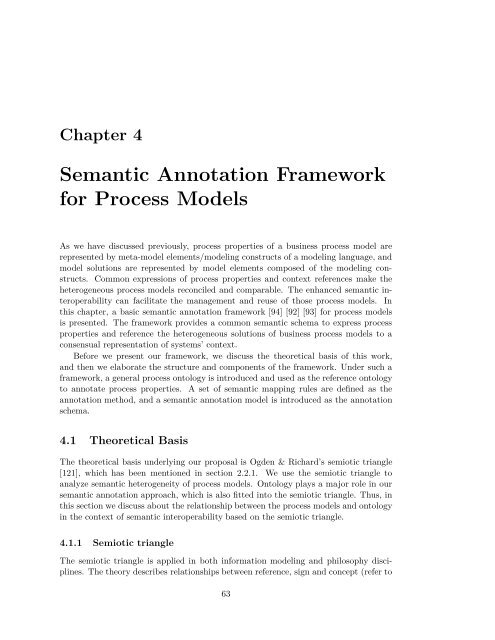Semantic Annotation for Process Models: - Department of Computer ...
Semantic Annotation for Process Models: - Department of Computer ...
Semantic Annotation for Process Models: - Department of Computer ...
Create successful ePaper yourself
Turn your PDF publications into a flip-book with our unique Google optimized e-Paper software.
Chapter 4<br />
<strong>Semantic</strong> <strong>Annotation</strong> Framework<br />
<strong>for</strong> <strong>Process</strong> <strong>Models</strong><br />
As we have discussed previously, process properties <strong>of</strong> a business process model are<br />
represented by meta-model elements/modeling constructs <strong>of</strong> a modeling language, and<br />
model solutions are represented by model elements composed <strong>of</strong> the modeling constructs.<br />
Common expressions <strong>of</strong> process properties and context references make the<br />
heterogeneous process models reconciled and comparable. The enhanced semantic interoperability<br />
can facilitate the management and reuse <strong>of</strong> those process models. In<br />
this chapter, a basic semantic annotation framework [94] [92] [93] <strong>for</strong> process models<br />
is presented. The framework provides a common semantic schema to express process<br />
properties and reference the heterogeneous solutions <strong>of</strong> business process models to a<br />
consensual representation <strong>of</strong> systems’ context.<br />
Be<strong>for</strong>e we present our framework, we discuss the theoretical basis <strong>of</strong> this work,<br />
and then we elaborate the structure and components <strong>of</strong> the framework. Under such a<br />
framework, a general process ontology is introduced and used as the reference ontology<br />
to annotate process properties. A set <strong>of</strong> semantic mapping rules are defined as the<br />
annotation method, and a semantic annotation model is introduced as the annotation<br />
schema.<br />
4.1 Theoretical Basis<br />
The theoretical basis underlying our proposal is Ogden & Richard’s semiotic triangle<br />
[121], which has been mentioned in section 2.2.1. We use the semiotic triangle to<br />
analyze semantic heterogeneity <strong>of</strong> process models. Ontology plays a major role in our<br />
semantic annotation approach, which is also fitted into the semiotic triangle. Thus, in<br />
this section we discuss about the relationship between the process models and ontology<br />
in the context <strong>of</strong> semantic interoperability based on the semiotic triangle.<br />
4.1.1 Semiotic triangle<br />
The semiotic triangle is applied in both in<strong>for</strong>mation modeling and philosophy disciplines.<br />
The theory describes relationships between reference, sign and concept (refer to<br />
63
















